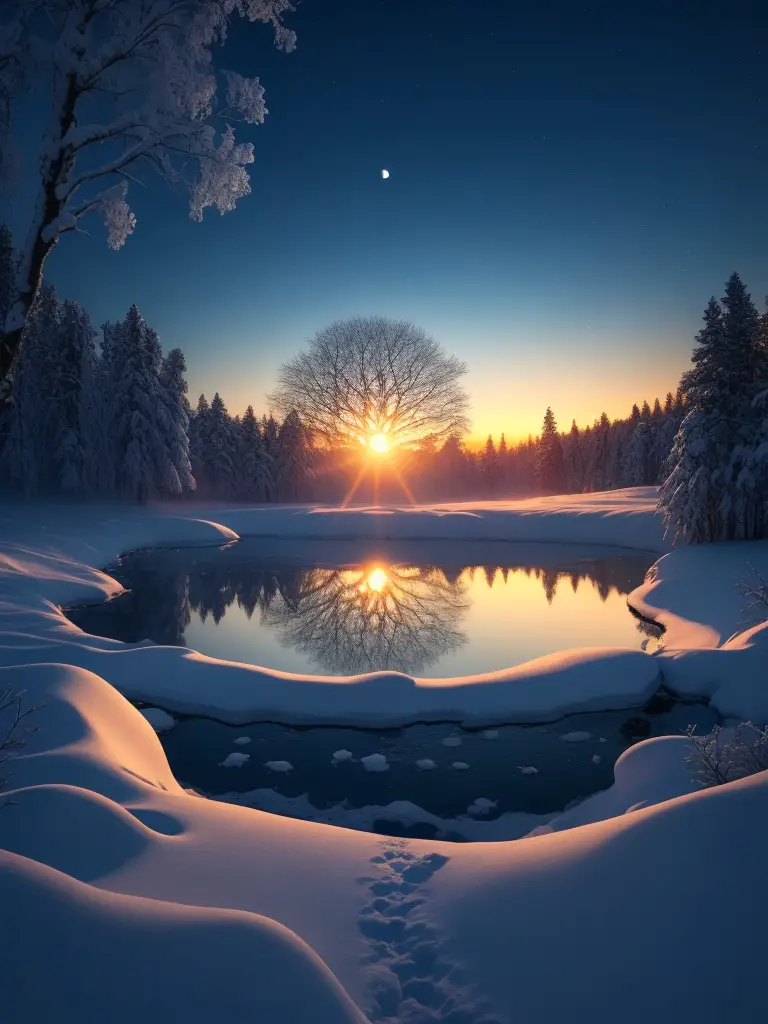When one of the Earth’s poles reaches its greatest tilt away from the Sun, a celestial event known as the winter solstice—also called the hibernal solstice—occurs. In the Northern Hemisphere, this astronomical phenomena denotes the shortest day and longest night of the year; in the Southern Hemisphere, it denotes the opposite.
The winter solstice has fascinated nations and religions throughout human history, inspiring a variety of customs and rituals. The winter solstice has great significance, dating back to ancient civilizations who honored the sun’s rebirth and continuing to this day with celebrations marking the passing of the seasons. Its occurrence not only denotes a turning point in our planet’s annual cycle but also represents hope, rebirth, and the victory of light over darkness.
The winter solstice encourages us to ponder the wonders of the universe and our place in it as the Earth approaches this critical juncture in its orbit. It serves as a reminder of life’s cycles, time’s ebb and flow, and the interdependence of all things. Therefore, let us embrace the wonder of this celestial event and marvel at the celestial dance that is unfolding above us as we experience the embrace of the winter solstice.
What is the Winter Solstice?
When one of Earth’s poles reaches its greatest tilt away from the Sun, an interesting astronomical phenomenon known as the winter solstice—also called the hibernal solstice—occurs. This unique instant indicates which direction the Sun is traveling in the sky—farthest north in the Southern Hemisphere or furthest south in the Northern Hemisphere.
This fascinating event usually occurs on December 21 or 22 in the Northern Hemisphere, marking the beginning of winter as well as the longest night and the shortest day of the year. On the other hand, this date marks the summer solstice in the Southern Hemisphere, when the longest day and the shortest night of the year occur.
The winter solstice is a significant event in many cultures and customs around the world. For millennia, people have commemorated and honored this day, which frequently represents rebirth, the cycle of life, and the victory of light over darkness. This captivating celestial event is linked to a plethora of unique rituals, customs, and celebrations that lend a touch of magic to the winter season.
Therefore, savor the beauty of the winter solstice and the natural treasures that surround us during this extraordinary time of year.
Understanding the Solstice
In order to fully understand the intricate workings of the solstice, let us to take a fascinating look at Earth’s yearly orbit around the bright Sun. In all its splendor, our planet tilts elegantly on its axis about 23.5 degrees with respect to its elliptical orbit. This position in space, along with the Earth’s eccentric orbit, creates a captivating sight: the Sun appears to travel across the wide sky, following a constantly shifting course as time goes on.
A crucial moment appears as the solstices draw near, almost as if the universe is directing it. Depending on the hemisphere and the season that our planet is in—summer or winter—the Sun reaches its zenith or nadir at noon. Nature’s captivating dance takes a significant turn around the winter solstice when the North Pole tilts furthest from the Sun, reducing the quantity of sunlight that reaches the Northern Hemisphere. It is during this cosmic waltz of stars that the days become shorter and the nights become more alluring, as though the winter magic takes over nature itself.
The Significance of the Winter Solstice
Throughout history, societies all around the world have placed great importance on the winter solstice, which marks the longest day and the shortest day of the year. It symbolizes a crucial turning point, the victory of light over darkness, and the prospect of regeneration and rejuvenation.
The celebration of Saturnalia marked the winter solstice in ancient Rome and was a time of feasting, revelry, and a reversal of social positions. Indigenous peoples celebrated this celestial event over the great landmass of North America with ceremonies and rituals that recognized the cyclical rhythm of life and the interconnection of all things natural.
The winter solstice’s cultural significance still exists today, despite the fact that its traditional customs have changed and incorporated with contemporary holiday celebrations. The winter solstice falls around the same time as several well-known traditions, like candle lighting, gift-giving, and getting together with loved ones. Holiday customs such as Hanukkah and Christmas provide witness to our continued ties to the natural world and to the human condition as a whole.
Every year, when the winter solstice draws near, it acts as a timeless reminder of life’s cycles, the splendor of the changing seasons, and the boundless capacity for rebirth that resides inside each of us.
Looking Ahead: The Winter Solstice in 2024
December 21, 2024, at 9:21 UTC6 is the date of the December solstice. This date reminds us of the amazing celestial physics that control our planet and the significant impact they have on our lives as it draws near.
The winter solstice provides an opportunity to stop and consider our place in the universe, whether you’re interested in the science underlying it or just find its deep cultural significance intriguing.
Thus, as the year’s shortest day draws near, why not pause to admire the elaborate dance between our planet and its star?
Sources
![]()
